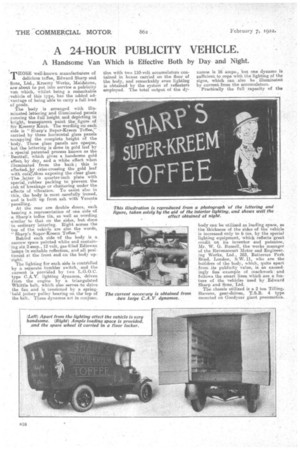A 24-HOUR PUBLICITY VEHICLE.
Page 18

If you've noticed an error in this article please click here to report it so we can fix it.
41111OSE well-known, manufacturers of delicious toffee, Edward Sharp and
• Sons, Ltd., Kreemy Works, Maidstone, are' about to put into service a publicity van, which, whilst being a remarkable .vehicle of this type, has the added ad:vantage of being able to carry a full load of goods. The body is arranged with illuminated lettering and illuminated panels running the foil height and depicting in bright, transparent paint the figure of Sir Kreemy Knut. The wording on each side is" Sharp's Super-Kreem Toffee," carried by three horizontal glass panels occupying the complete height of the ' body. These glass panels are opaque, but the lettering is done in gold leaf by a'sPecial patented process known as the • Beuttell, which gives a handsome gold effect by day, and a white effect when illuminated from the back ; this is effectecL,by cries-creasing the gold leaf with euts;,thns exposing the clear glass. • The latter is quarter-inch plate with specfal, rubber packing to prevent the risk of breakage or chattering under the effects of vibration. To assist also in this, the body is most carefully ironed, and is built up from ash with Venesta panelling. At the rear are double doors, each • bearing a .representation of one side of • a Sharp's toffee tin, as well as wording • similar to that on the sides, but done in ordinary lettering. Right across the top of the vehicle are also the words, • "Sharp's Super-Kreem Toffee." Behind each side of the body is a narrow space painted white and contain' ing six 2 amp., 12 volt, gas-filled Ediswan 'lamps in suitable reflectors, and all positioned. at the front end on the body upright. The lighting for each side is contiolled by a separate tumbler switch, and the current is provided by two L.G.O.C. type O.A.V. lighting dynamos, driven from the engine by a triangulated Whittle belt, which also serves-to drive the fan and is tensioned by a spring' held jockey pulley bearing on the top of the belt. These dynamos act in conjunc_ tion with two 110-volt accumulators contained in boxes carried on the floor of the body, and remarkably even lighting is obtained by the system of reflectors employed. The total output of the dy namos is 16 amps., but one dynamo is 4ufficient to cope with the lighting of the signs, which can also be illuminated by current from the accumulators. Practically the full capacity of the body can be utilized as loading space, as the thickness of the sides of the vehicle is increased only to 6 ina, by the special lighting equipment, which reflects great credit on its inventor and patentee, Mr. W. G. Russell, the works manager of the Ravenscourt Motor and-Engineering Works, Ltd., 283, Battersea Park Road, London, S.W. 11, who are the builders of the body, which, quite apart from its publicity value, is an exceedingly fine example of coachwork and follows the smart lines which are a feature of the vehicles used by Edward Sharp and Sons, Ltd.
The chassis utilized is a 2 ton Tilling. Stevens, gear-driven, T.S.B. 4 type mounted on Goodyear giant pneumatics.




























